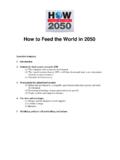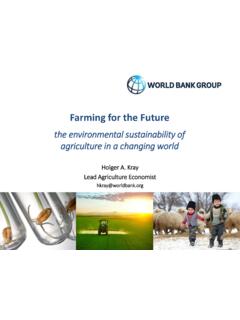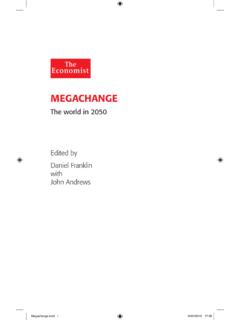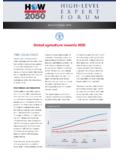Transcription of The World in 2050 - SETE
1 The World in 2050Dr. Ian YeomanEuropean Tourism Futures Institute 1 The World in 2050 The World in 2050 Implications for marketing, branding and distributionThe World in 2050 ResourcesWealthTechnologyWealth45 Changing MarketsAverage Annual GDP Growth Real GDP in 2050 at 2005 US $ & Stancil 20106 Changing MarketsAverage Annual GDP Growth Real GDP in 2050 at 2005 US $ & Stancil 2010 Net Gen by Population7 Country% of total population under 25 Growth in under-25 population since 1980 India5246 China38-9 United States3511 Brazil4722 Mexico4914 Russia32-15 Japan25-27 Germany26-20 France31-7UK31-10 Spain27-27 Canada31-4 Source: UN 2009 Net Gen by Population8 Country% of total population under 25 Growth in under-25 population since 1980 India5246 China38-9 United States3511 Brazil4722 Mexico4914 Russia32-15 Japan25-27 Germany26-20 France31-7UK31-10 Spain27-27 Canada31-4 Source: UN 2009 Changing Life Courses9 Early Life: Growth and DevelopmentAdult Maintaining highest possible level of functionDisability thresholdOlder AgeMaintaining independence andPreventing disabilityRange of functions in individualsAgeFunctionality of capacity Rehabilitation and ensuring the quality of lifeSource.
2 Yeoman & Butterfield 20101011 Changing Life Courses020406080100 ItalyKoreaUSAN etherlandsUKDenmarkBelgiumNew ZealandSwedenJapanGermanyFranceAustralia Selected OECD countriesReplacement ratio % Projections of potential replacement ration in 2050 at normal retirement (as a % of final salary)Public Pension Voluntary occuptional pensionMandatory private pensionTarget replacementrate at 70%Source: Yeoman & Butterfield 20101213 New TouristThe transition of changing valuesFluid identitySimplicityFlatters & Wilmott 2009 Resources 17 Thomas Malthus has become widely known for his theories concerning population and its increase or decrease in response to various factors. The six editions of hisAn Essay on the Principle of Population,published from 1798 to 1826, observed that sooner or later population gets checked byfamineanddisease.
3 Source: Krumdiek et al, (2010), Becken (2010)What Can We Learn From History?19 Future of Flight20 Future of Transport21 Future of Transport22 Tesla RoadsterRobotic Power SuitesFuture of Food23 Source: Lipschutz (2006)Future of Food The film raises a number of issues: Who controls the food supply, food security and scramble for food Food and culture Forthcoming food inflation Wealth distribution: Have s and have not s Urbanisation Food supplements, science and healthy lifestyle Sex tourism and the role of women24 Urbanisation: Logan s Run25By 2050, most regions of the World will be predominantly urban as 193,107 new city dwellers are added to the World s urban population every day. This translates to slightly more than two people every two seconds reflecting that the World s urban population will swell to almost 5 bn in 2030 and bn by 2050.
4 Cities have long been the centre of tourist activity, from the early times of civilisation through to their highlydeveloped state in the global economy. Cities hold a particular fascination for tourists, from the vast highly developed metropolitan citieslike Los Angeles to small historic cities like Durham in the North East of England (Yeoman 2011).Urbanisation: Logan s Run26 The film raises a number of issues: Peak oil and the affordability of air travel Environmental taxation Fiscal deficit Urban land transport Urbanisation and immigration Assault on pleasure Green technologiesShanghai 2050: The Future of Hotels Shanghai is the first place of everything that is modern about China, whether it was the first motor car, first train tracks, first cinema and first modern sewers. Shanghai has recorded double-digit growth for 15 consecutive years since 1992 to become the centre of finance and trade in new China Domestic tourist arrivals quadrupled between 1993 and 2009 from billion billion tourists.
5 International tourist arrivals have grown fivefold from27 million tourists in 1990 to 126 visitors in 2009, reflecting a CAGR of Shanghai s rapid urbanization has resulted in negative environmental impacts such as pollution. Coupled with external factors such as climate change, competition of urban land space and decreasing availability of clean water, Shanghai s urban development plan would require a sustainable design of the Hotel Design Sustainable architecture seeks to minimize the negative environmental impact of buildings by enhancing efficiency and moderation in the use of materials, energy, and development : Songjiang HotelModernity of Design29 Futuris30 Space is Scarce New Sciences31 Programmable matter3233 Close the Housekeeping DepartmentNanotechnologyis widely regarded as one of the twenty-first century s key technologies, and its economic importance is sharply on the rise.
6 In architecture and the construction industry it has potentials that are already usable today, especially the coating of surfaces to lend them functional characteristics such as increased tensile strength, self-cleaning capacity, fire resistance, and s self cleaning glassFuture of the Meetings Industry34 Events 0500100015002000250030003500400045005000 1998199920002001200220032004200520062007 2008 Absolute figuresMedical scienceTechnologyScienceIndustryOther Meetings by Sector (Source: ICCA)Meetings Industry Key issues for the medical tourism meetings industry The convergence of science and technologies. The cost of discovery and less discovery. Moving east. Science parks, elite universities and knowledge clusters. Assault on pleasure. Virtual reality and meetings technologies. We will still want to talk to each other face to face of Sporting Events37 What will the fan experience be?
7 Real or virtualINSPERIENCE ECONOMYU ltimate Outdoor TheatreSource: Trend HunterINSPERIENCE ECONOMY represents consumers' desire to bring top-level experiences into their domesticdomain."Key words Creating comfortable space Fully equipped Not venturing out because we have it at home The best The Cal Spas Outdoor Theatre, at US $30,000 comes with 63-inch LCD HDTV touting surround sound, DVD/CD BBQ grill, a wet bar, weatherproof recliners with cup holders2050: An Information Society The role of technology in tourism is increasinglybecoming more pronounced. Constant innovations and developments of new technologies allow users and suppliers to interact on platforms that were unimaginable in the past decade. Today, the provision of information on tourism products is available through a variety of channels and technological platforms, bringing with it a range of benefits such as convenience with user-friendly interfaces, up-to-date information and affordability to the end user.
8 These developments increasingly drives the integration of technology within our everyday lives with mobile internet, navigation systems and smartphones, which attempts to constantly keep us connected to the digital : An Information Society The role of technology in tourism is increasinglybecoming more pronounced. Constant innovationsand developments of newtechnologies allow users and suppliers to interact on platforms that were unimaginable in the past decade. Today, the provision of information on tourism products is available through a variety of channels and technological platforms, bringing with it a range of benefits such as convenience with user-friendly interfaces, up-to-date information and affordability to the end user.
9 These developments increasingly drives the integration of technologywithin our everyday lives with mobile internet, navigation systems and smartphones, which attempts to constantly keep us connected to the digital this is only the beginning422050: An Information Society43 Ubiquitous ComputingVirtual Reality In Japan 30% of online travel agents report 30% of hotel bookings coming via mobile phones on the day of arrival (Hatton 2009)Augmented audio and visual recognitiontechnology means that a smartphone with acamera can recognise the environment and provide information45 Scientists at the University of Washington have been developing acontact lens containing one built-in LED, powered wirelessly with radio frequency waves, facial recognition systems etc (Nelson 2008)2050: An Information Society47482050: An Information SocietyGestural Interfaces49A gestural interface is a platform that bridges communication between humans by inventing measures which allow computers to understandhuman body language (Yeoman 2011).
10 The best example of future development is the Sixth Sense Project or google Pranav Mistry When will Moore s end?Moore's lawis the number oftransistorsthat can be placed inexpensively on anintegrated circuithas doubled approximately every two yearsPredictions about the deathof Moore's Law have been wrong several times, too. In 1978, IBM scientists predicted Moore's Law had only 10 years left. When they got to 1988, they said it would end in 10 years again. (Kanellos 2005 )50 Optical computing uses light beams to store information and perform conventional silicon-based electronic processors reach theoretical limits, optical computers present an attractive alternative, because they are much faster and energy efficient. (Techcast 2010)51 What is the Future of Visitor Information Centres?Ciudad Grupo Santander, Madrid52 Technology and LifeEight Net Gen Norms They want freedom in everything they do, from freedom of choice to freedom of expression They love to customise, personalise They are the new scrutinizers They look for corporate integrity and openness when deciding what to buy and where to work The Net Gen wants entertainment and play in their work, education, and social life They are the collaboration and relationship generation The Net Gen has a need for speed and not just in video games They are the innovators53 Artificial IntelligenceSince 1950 when Alan Turing defined the Turing Test in which computers are indistinguishable from human behaviour.









